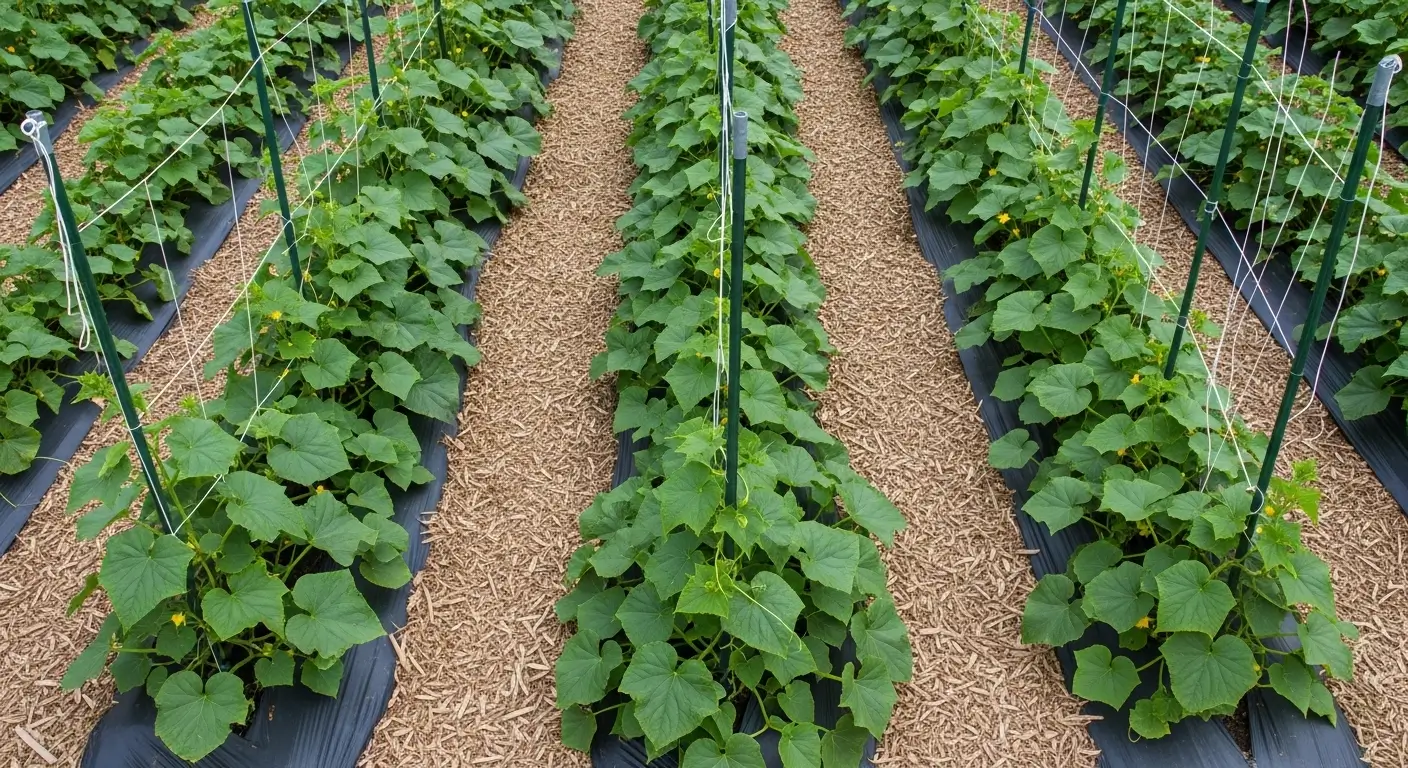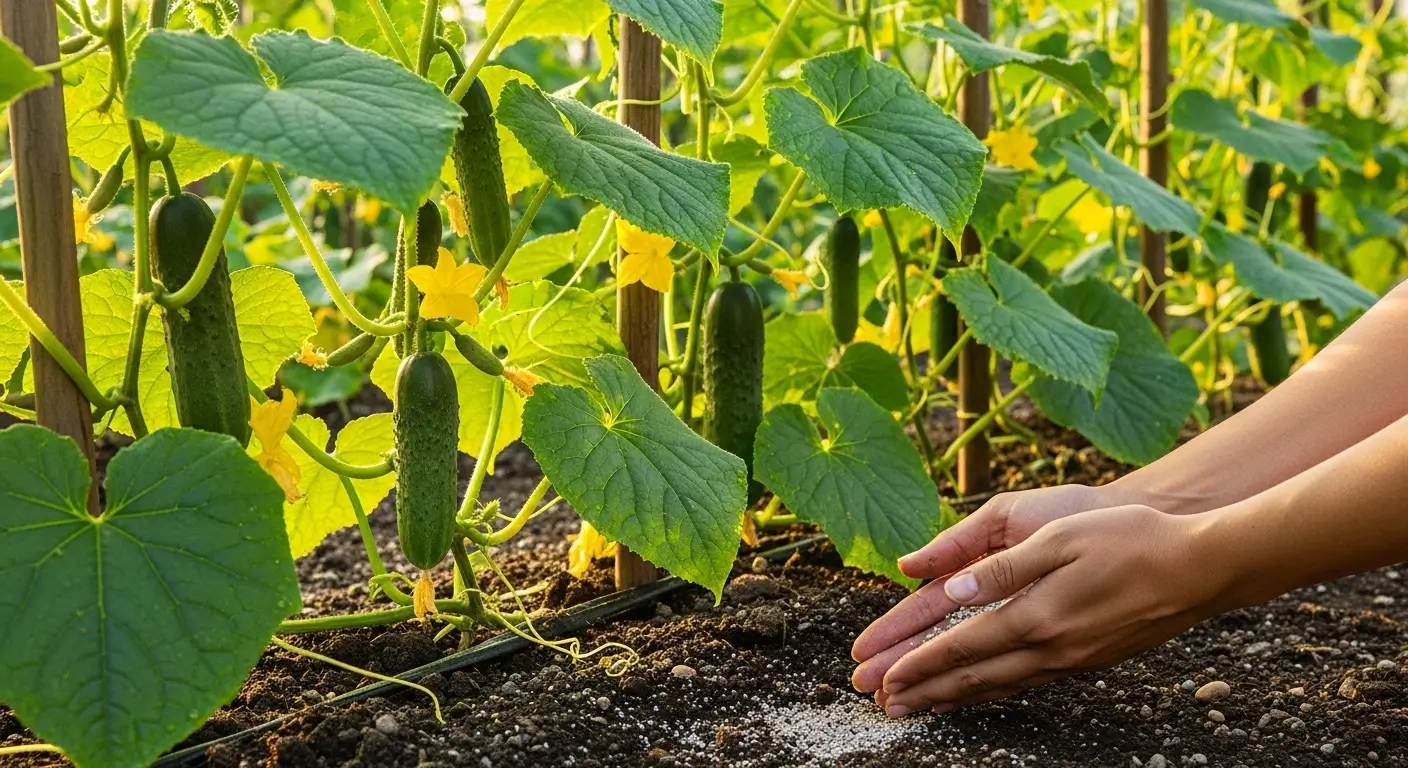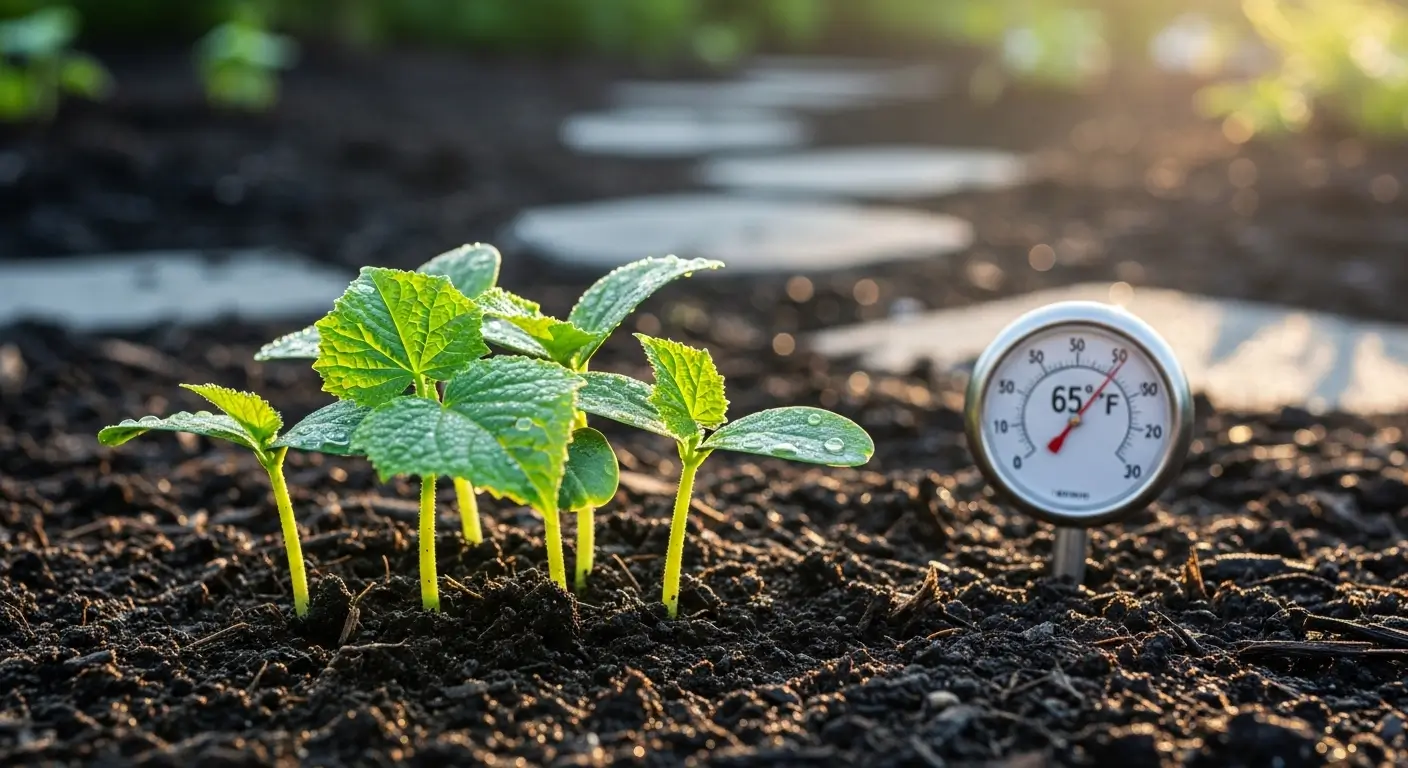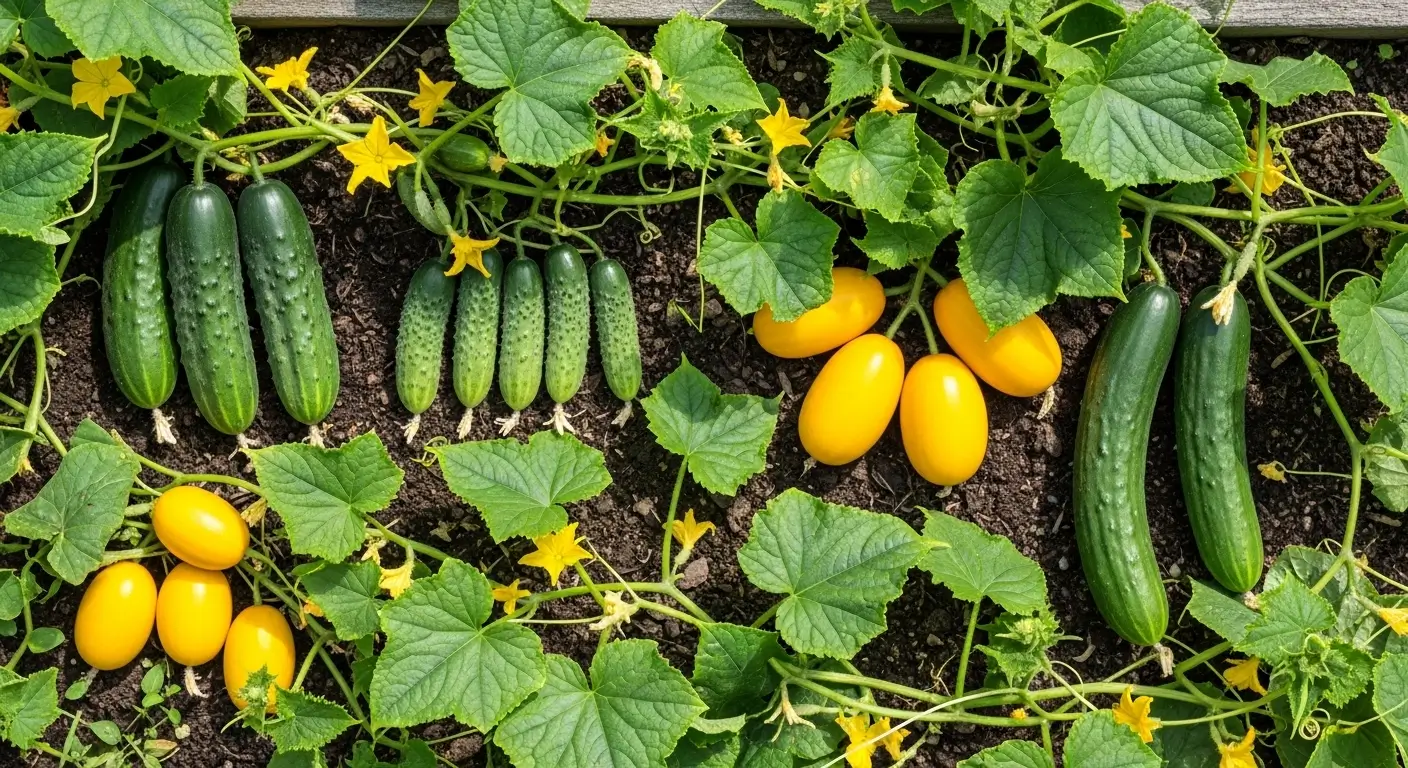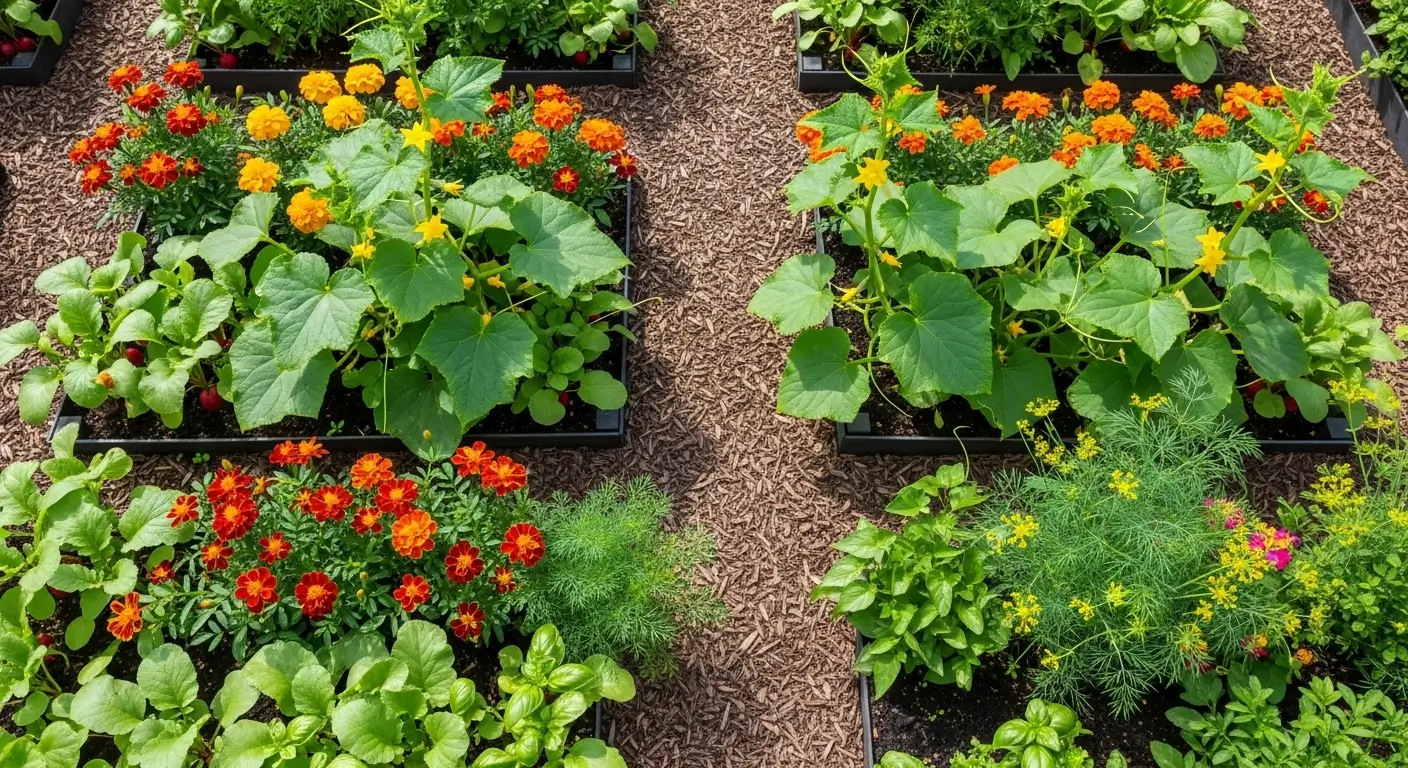Okay, so here’s the deal – I used to be that gardener who’d plant cucumber seeds, watch these gorgeous green vines take over my garden, and then stand there like an idiot wondering where all my actual cucumbers were. Can you relate?
It turns out that the whole time, I missed the most obvious thing: cucumber pollination. I mean, seriously, it was staring me right in the face!
After growing cucumbers for about 15 years here in my little Naperville garden (and trust me, I’ve screwed up more times than I care to admit), I finally figured out that understanding cucumber pollination is like having a secret weapon. Today I’m gonna spill everything I know about male vs female cucumber flowers and identifying cucumber flowers – because once you get this stuff, your cucumber game will never be the same.
Table of Contents
Quick Key Takeaways
- Male flowers show up first and make the pollen; female ones have tiny baby cucumbers at the bottom
- Most cucumbers need both types of flowers to make babies (so to speak)
- Weather, bees, and how happy your plant is all mess with pollination
- You can totally do it yourself with your hands (easier than it sounds!)
- Inadequate pollination = weird-looking or no cucumbers (learned this the hard way)
The Cucumber Pollination Basics (What I Wish Someone Had Told Me Years Ago)
Here’s what nobody mentions when you’re starting out: cucumber pollination isn’t some “set it and forget it” deal. These plants are high-maintenance when it comes to making babies.
Cucumbers are what fancy people call “monoecious, ” meaning each plant has both boy and girl parts, but they’re on separate flowers. And here’s the kicker – they need help getting the pollen from the boy and girl flowers. They can’t just figure it out independently like some plants do.
I’ll never forget my second year growing cucumbers. I was SO excited when I saw all these beautiful yellow flowers covering my vines. I’m thinking, “Yes! Cucumber jackpot coming my way!” Then I’d sit there day after day watching those flowers just… drop off. Like, what the heck, plants?
I didn’t know that most of what I saw were male flowers doing precisely what they’re supposed to do – bloom, dump their pollen, and peace out. The magic only happens when something (bees, other bugs, or even us) moves that pollen over to the female flowers. That’s when you get those gorgeous, crunchy cucumbers we’re all obsessed with.
Identifying Cucumber Flowers: Male vs Female (This Changed Everything for Me)
Learning the difference between male vs female cucumber flowers was honestly like someone turned on a light bulb in my brain. Once you know what you’re looking for, it’s super obvious – and I promise this knowledge will totally change how you think about your cucumber plants.
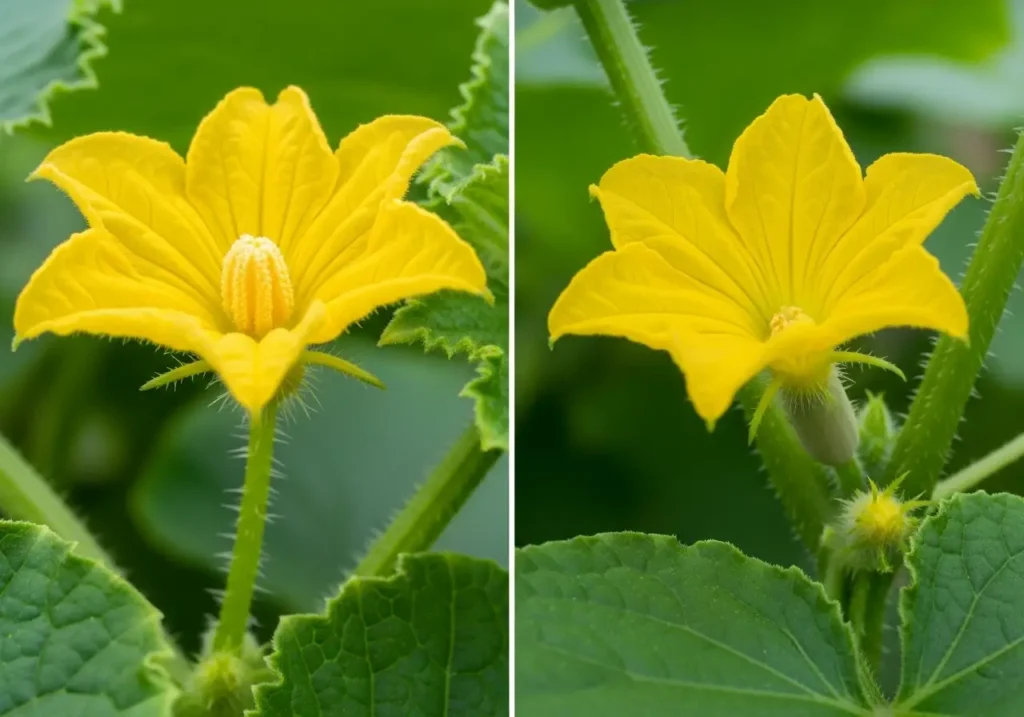
Male Cucumber Flowers: The Pollen Factories
These guys are always the first to crash the party, usually showing up about 10-14 days before any female flowers even think about appearing. I get all excited when I see these first blooms because I know the ladies aren’t far behind.
Here’s how to spot the boys:
- They’re on these long, skinny stems (like they’re showing off)
- No little bump or anything weird at the bottom of the flower
- They’ve got this prominent yellow center that’s absolutely covered in pollen
- They hang out in groups – like a boys’ night out
- They open up super early in the morning and usually call it quits by afternoon
In my garden, healthy cucumber plants will pump out way more male flowers than female ones – sometimes it’s like 10 guys to every 1 girl. Don’t freak out if this is what you’re seeing! It’s totally normal, even though it looks crazy.
Female Cucumber Flowers: The VIPs
These flowers’ll become your cucumbers, and spotting your first female flower is pretty thrilling once you know what you’re looking for.
Here’s what makes them special:
- There’s this tiny little cucumber bump right at the base of the flower (so cute!)
- That little bump literally looks like a baby cucumber – because that’s precisely what it is
- They’re usually loners, not hanging out in groups like the males
- The flower sits right on top of that mini cucumber
- Inside, instead of pollen-covered stuff, you’ll see this star-shaped thing (the stigma)
I love finding female flowers because each one is like finding a little present. That tiny bump will either grow into a whole cucumber (if everything goes right) or turn yellow and drop off (if things go wrong).
The Timing Game I’ve Figured Out
Over the years, I’ve noticed some predictable patterns. Male flowers totally dominate early in the season – sometimes for weeks before you see your first female flower. This used to make me panic, but now I know the plant’s just making sure there’s plenty of pollen ready when those female flowers finally show up.
Weather messes with this timing, too. During those brutal heat waves we get here in Illinois (ugh, don’t get me started), I’ve seen plants get stingy with female flowers. But when conditions are perfect – warm days, cool nights – you get this beautiful balance that makes my gardener heart happy.
The Pollination Process: What Actually Needs to Happen
Getting the mechanics of cucumber pollination down has seriously levelled up my cucumber-growing game. Here’s the deal:
When Nature Does Its Thing
When everything’s working right, bees and other little pollinators visit the male flowers in the morning to grab some pollen. As they’re buzzing around, pollen sticks all over their fuzzy bodies. Then, when they hit up a female flower next, boom – some of that pollen ends up where it needs to be. If enough good pollen makes it to the right spot, that little cucumber starts growing.
I’ve spent way too many early mornings watching this happen in my garden with my coffee in hand. It’s pretty cool to watch, though I sometimes worry the bees aren’t doing their job well enough.
When Things Go Wrong
Lots of stuff can mess up natural cucumber pollination:
Crappy weather: Rain, crazy winds, or those days when it’s hot enough to fry an egg on the sidewalk keep the pollinators away. I’ve had summers where it seemed like it rained daily, washing all the pollen off my poor plants.
Not enough bees: If your area doesn’t have many pollinators, natural pollination just doesn’t work well. This has gotten worse over the years, so I started planting many bee-friendly flowers around my veggie garden. According to USDA pollinator research, supporting diverse pollinator populations is crucial for maintaining healthy agricultural systems, including home gardens.
Bad timing: Sometimes the male and female flowers aren’t open simultaneously, especially early in the season or when plants are stressed out.
Unhappy plants: When plants are having a rough time with water, heat, or nutrients, they might not make good pollen, or they’ll just drop those precious female flowers.
Hand Pollination: Your Secret Superpower
Okay, here’s where I’m gonna share one of my favorite cucumber tricks: doing the pollination yourself. It’s actually pretty easy and can totally transform your cucumber harvest.
When I Break Out the Hand Pollination
I do this when:
- I see tons of male flowers but zero developing cucumbers
- The weather’s been terrible for bees
- I want to squeeze every cucumber possible out of a small space
- I’m growing cucumbers in my greenhouse
How I Do It (It’s Easier Than You Think)
First, you gotta find fresh male and female flowers that are both open on the same day. This usually happens in the morning.
Here’s my step-by-step:
- Grab a male flower: Pick one that’s wide open with obvious pollen on the center part
- Strip it down: Gently pull off all the petals so you’re left with just the pollen-covered center
- Find a female flower: Look for an open female with that cute little cucumber bump
- Do the deed: Gently dab the male flower’s center all over the star-shaped thing in the female flower
- Be thorough: I make sure to hit the whole center area – don’t be shy about it
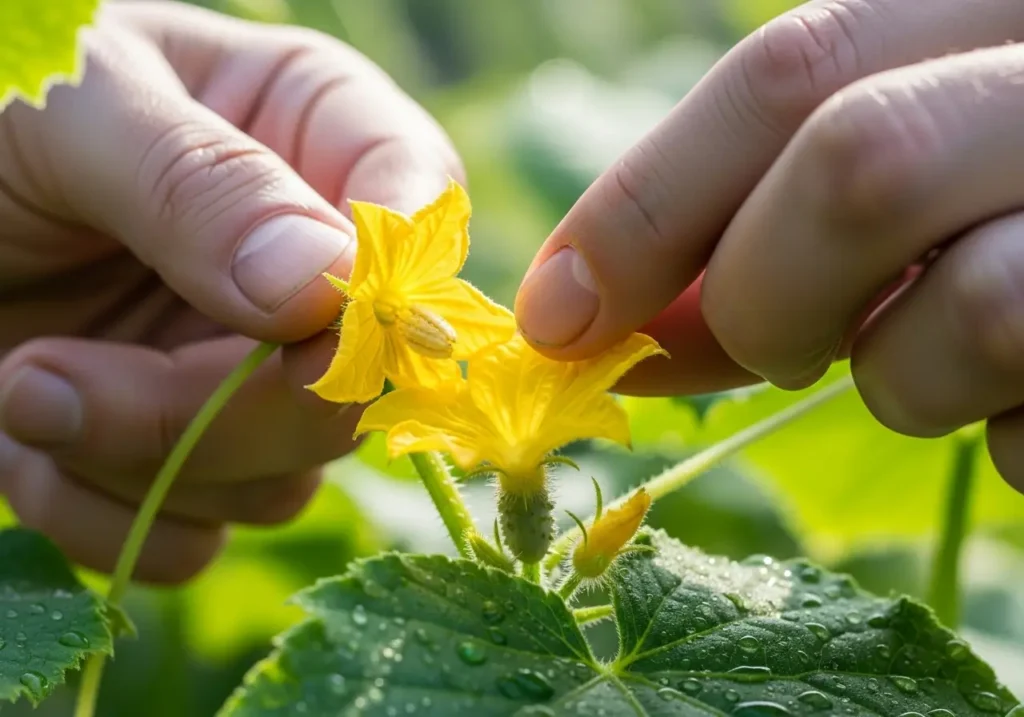
My Pro Tips for Hand Pollination
- Do this early morning (7-10 AM) when everything’s fresh and the pollen’s at its best
- One male flower can handle 2-3 female flowers
- Be gentle – these flower parts are delicate
- I use little pieces of colored tape to mark which ones I’ve done, so I can track my success
I started doing this a few years back when I was getting bummed about my cucumber yields, and wow – what a game changer! I went from maybe 40% of my female flowers actually making cucumbers to over 80%. Not kidding.
Common Pollination Problems (And How I Fixed Them)
Let me tell you about the most annoying cucumber pollination problems I’ve run into and what actually worked to fix them.
Problem: Tons of Flowers, Zero Cucumbers
This was my biggest headache when I first started. The plants looked amazing, flowers everywhere, but absolutely no cucumbers. So frustrating!
What I figured out: Usually means terrible pollination. Either there aren’t enough bees around, or something’s preventing the pollen from getting where it needs to go.
What worked: Hand pollination became my best friend, plus I planted a bunch more flowers that bees love near my cucumber patch. Zinnias and cosmos have been rock stars for this.
Problem: Weird-Looking, Wonky Cucumbers
Sometimes you get cucumbers that start growing but end up looking all wrong – fat on one end, skinny on the other, or they just quit growing halfway through.
Why this happens: Crappy pollination job. When only part of the female flower gets pollinated, only part of the cucumber develops properly.
My fix: This is exactly why I hand-pollinate now. When I do it myself, I can ensure the whole thing gets covered properly.
Problem: Female Flowers Just Giving Up
Nothing’s more heartbreaking than watching those adorable little cucumber bulbs turn yellow and fall off.
What causes this disaster:
- Zero pollination happened
- The plant is stressed from water issues, temperature swings, or nutrient problems
- Too much nitrogen (makes plants focus on leaves instead of fruit)
What saved my sanity: Consistent watering, not going crazy with fertilizer, and yep – more hand pollination. I also learned that plants will naturally dump some female flowers if they’re trying to support more fruit than they can handle.
Weather and Environment Stuff That Messes With Pollination
Over the years, I’ve noticed how much the weather and environment can totally make or break cucumber pollination. Understanding this stuff has helped me time everything better.
Temperature Drama
Cucumbers are picky about temperature. In my experience, pollination works best when:
- Days are between 70-85°F (nice and comfortable)
- Nights stay above 60°F
- We don’t get those crazy temperature swings
During heat waves (and trust me, Illinois gets some brutal ones), both the bees disappear, and the pollen doesn’t work as well. When it’s consistently hitting the mid-90s, I focus way more on hand pollinating super early in the morning.
Humidity and Weather Weirdness
Too much humidity can mess with pollen release, while super dry conditions make the pollen die off too fast. I’ve had the best luck during those perfect late spring/early summer periods when humidity’s reasonable and we get regular rain but not too much.
Rainy stretches are the worst because they wash the pollen away and keep all the pollinators hiding inside. During wet spells, I actually cover my cucumber flowers in the evening and uncover them in the morning for hand pollination.
The Pollinator Situation
This is huge, and it’s gotten trickier over the years. I’ve had to get way more intentional about keeping pollinators happy in my garden.
What I’ve done to help:
- Planted tons of different flowers that bloom all season long
- Cut way back on pesticides (even the organic ones can mess with good bugs)
- Put out shallow water dishes for the pollinators
- Let parts of my garden get a little wild for native bee homes
If you’re dealing with low bee activity, hand pollination really can be the difference between a sad cucumber harvest and more cucumbers than you know what to do with.
My Best Tips for Cucumber Pollination Success
After years of figuring this stuff out (and making plenty of mistakes), here’s what actually works:
Picking the Right Varieties
Some cucumber types are just way more reliable than others. I’ve had consistently better luck with:
- Regular old cucumber varieties over some of the fancy new hybrids
- Varieties that are meant for my area
- Open-pollinated types that seem to have stronger flowering
If you’re struggling with growing cucumbers in general, definitely check out my complete guide to growing cucumbers for variety suggestions and growing tips.
Playing the Timing Game
I’ve learned to plant new cucumber seeds every 2-3 weeks instead of doing it all at once. This way, I’ve got plants flowering at different times all season, which helps with overall pollination success. Plus, I get cucumbers for way longer, which is fantastic.
Keeping Plants Happy
Healthy plants produce more flowers and produce better pollination success. My non-negotiables:
- Consistent watering (about an inch per week)
- Good soil with lots of compost mixed in
- Balanced fertilizer (don’t go crazy with the nitrogen)
- Good airflow to prevent diseases
For specific plant problems, I’ve got a detailed cucumber plant problems guide that covers troubleshooting all the common stuff.
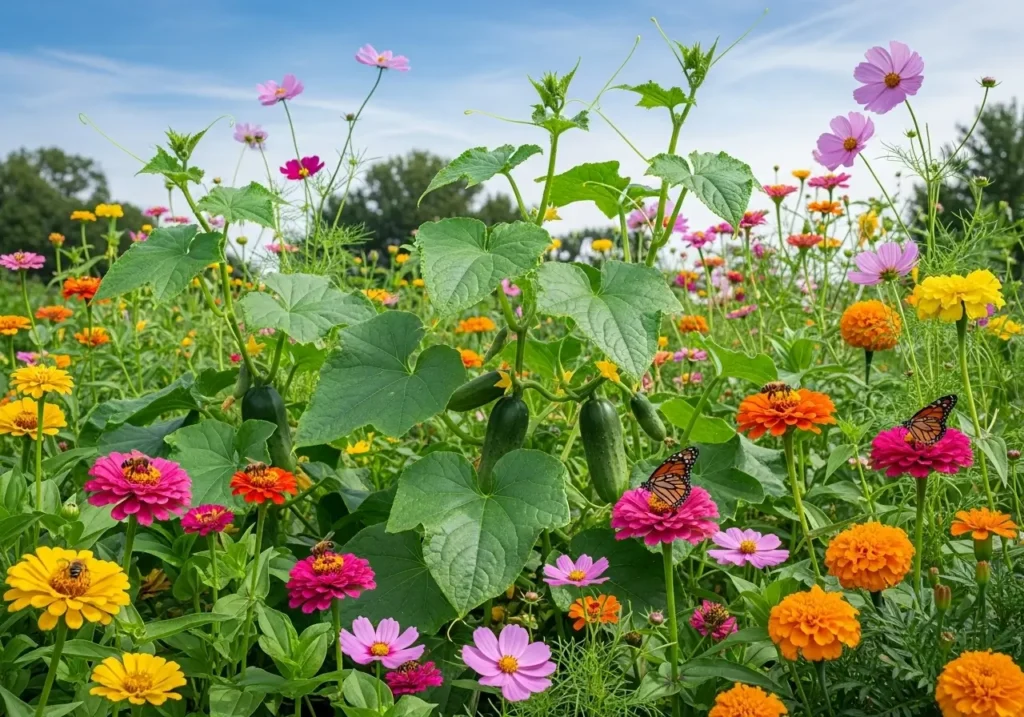
Making Bees Happy
Beyond just planting flowers, I’ve found other ways to get more pollinator action:
- Don’t spray anything during flowering time.
- Keep shallow water sources near the cucumber area.
- Plant herbs like dill and cilantro nearby (bees love them, plus they’re helpful)
- Keep some messier areas for native bees to nest.
Special Situations and Weird Growing Setups
Not everyone’s got a considerable backyard garden, and I’ve learned that different growing situations need different approaches.
Container Growing
If you’re growing cucumbers in containers, pollination can be trickier because you might not get as many bee visitors. Container cucumbers are perfect candidates for hand pollination.
I also suggest picking compact varieties and putting containers where they get morning sun, but some protection from brutal afternoon heat.
Greenhouse Growing
Natural pollination is basically impossible in greenhouses or hoop houses, so hand pollination becomes essential. The upside is you control the environment way more, so you can dial in the perfect conditions for flowering.
Tiny Gardens
You might not have room for tons of bee-attracting plants in smaller spaces. Focus on companion planting with flowers that bloom when your cucumbers do, and don’t skip hand pollination – it’s pretty relaxing once you get into it.
Troubleshooting Your Specific Situation
Let me walk through some stuff I hear about all the time:
“My cucumber plants have been blooming forever, but I haven’t seen one cucumber start growing.”
This usually means you see mostly male flowers (remember, they show up first), or pollination isn’t happening. Give a little more time for female flowers to appear, and start hand pollinating as soon as you spot them.
“I see tiny cucumbers starting, but they turn yellow and fall off.”
Classic pollination fail. The female flower didn’t get pollinated properly, so the plant just gives up on that fruit. Hand pollination should totally fix this.
“My cucumbers are growing, but they look weird – some skinny, some fat, just all wrong.”
Partial pollination is the culprit. You get wonky fruit when only part of the female flower gets pollinated. A better hand pollination technique (making sure to hit the whole center area) should give you normal-looking cucumbers.
What You Should Do Right Now
If you’re dealing with cucumber pollination issues, here’s what I’d do if I were you:
- Go check out your plants right now – Get familiar with spotting male vs female flowers.
- See how much bee action you’ve got – Hang out in the garden in the morning and see what’s happening.
- Try hand pollinating a few flowers – Even if you think natural pollination is working, doing a few yourself will help you understand the whole process.
- Look at your garden setup – Do you have enough flowering plants to keep bees happy all season?
Cucumber pollination might seem complicated at first, but once you get the hang of it, it becomes totally automatic. I swear that understanding this stuff will completely change your cucumber-growing game.
Every year, I’m still amazed by how much better I’ve gotten at this. Those early years of disappointing cucumber harvests taught me that sometimes the most essential garden knowledge comes from paying attention to the little stuff – like knowing which flowers are which.
So what’s your biggest cucumber challenge? Have you tried pollinating yourself, or are you counting on the bees to handle everything? I’d love to hear what you’re dealing with and any questions about getting those flowers to turn into cucumbers. Please drop me a comment and let’s figure this out together!
Cucumber Pollination Problems and Solutions
Why do my cucumber plants have lots of flowers but no cucumbers growing?
Oh, this is super frustrating and I’ve totally been there! Usually this means you’re seeing mostly male flowers (which show up first and then drop off) or the pollination just isn’t happening. The female flowers either aren’t getting pollinated or there aren’t many female flowers yet. Give it a bit more time for female flowers to appear, and definitely try hand pollinating – it’s easier than you think and can completely turn things around!
How can I tell the difference between male and female cucumber flowers?
Once you know what to look for, it’s actually pretty obvious! Female flowers are the special ones – they have this cute little cucumber bulb right at the base of the flower that looks like a tiny cucumber. Male flowers grow on long skinny stems, often in groups, and have this prominent yellow center covered in pollen but no little bulb. Think of it this way: if you see a mini cucumber, it’s female!
When should I hand pollinate my cucumber flowers?
Early morning is your sweet spot – between 7 and 10 AM when the flowers are fresh and the pollen is at its best. You want both the male and female flowers to be open on the same day, which usually happens in the morning. I like to do this with my coffee in hand – it’s actually pretty relaxing once you get the hang of it!
Why are my cucumbers growing weird shapes or stopping halfway?
This is classic partial pollination! When only part of the female flower gets pollinated properly, you end up with wonky cucumbers – fat on one end, skinny on the other, or they just quit growing. It’s like the plant is saying “eh, good enough” instead of developing the whole fruit. Better hand pollination technique usually fixes this – make sure you’re covering that whole center area of the female flower!

